FREE shipping on orders over $49!* Details
- All Products
- Home Decor
- Decorative Accents
- Telescopes
Telescopes
58 Results
Sort by:
Price
58 Results
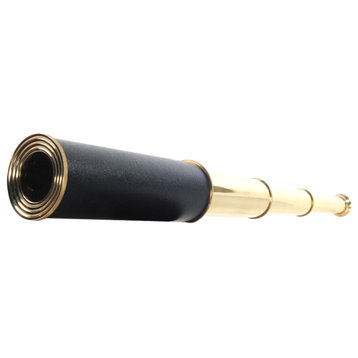
Handheld Telescope In Wood Boxby Old Modern Handicrafts, Inc.(1)
$74
Free Shipping
This hand held telescope is made of high quality brass. Each component is crafted with the finest craftsmanship. It comes with black leather overlay and is available in a shiny brass finish. It also comes with a wooden box made from solid rosewood. This is a great item to use and add to any nautical collection. The item dimensions are: L: 15 inches extended, W: 1.5 inches, H: 1.5 inches.
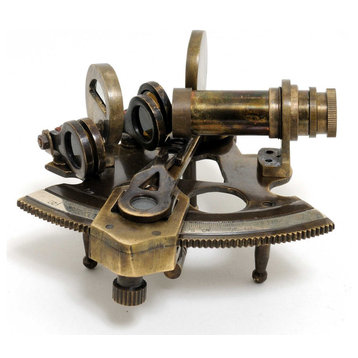
4" X 4" X 2.5" Nautical Sextant In Leather Case Smallby HomeRoots
$62
Free Shipping
This is a functional replica of the nautical sextant. It is made of high quality brass. Each component is crafted with finest craftsmanship. Using rack and pinion mechanism, this sextant was given a heavy pattern of solid brass. Available in antique brass finish and it comes in a beautiful leather gift box. This sextant is a great addition to any nautical collection. The item dimensions are: L: 4 inches, W: 4 inches, H: 2.5 inches.
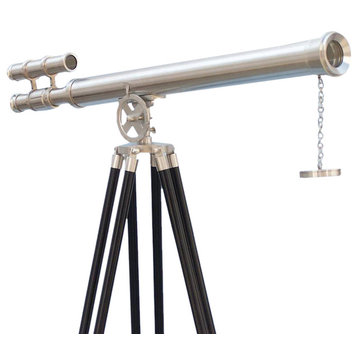
Floor Standing Brushed Nickel Griffith Astro Telescope 65'', Marine Telescopeby Handcrafted Nautical DecorSponsored
$500
The Hampton Nautical Floor Standing Brushed Nickel Griffith Astro Telescope 65" with view finder is the pinnacle of our wide telescope selection. This beautiful brushed nickel telescope is mounted on a wooden tripod. This telescope is a beautifully functioning nautical masterpiece, with a 42mm objective lens that produces up to 15x magnification.Focusing is accomplished by adjusting the eyepiece ring on the telescope tube and a removable brushed nickel cap, connected by a chain, protects the objective lens.--The wooden tripod stand features smooth, polished and round legs, each with brushed nickel fittings and a screw release to let you adjust the height. A brushed nickel chain holds the three wooden legs together to maintain the telescope's position.--Dimensions: 65" H x 25" W x 32" L---- 15X Magnification-- Brushed Nickel telescope body-- Glass optics for a clear view (not plastic lenses)-- Fully functional telescope focuses and magnifies-- Sturdy wooden tripod supports telescope when standing-- -- Custom engraving/photo etching available: Logos, pictures, or slogans can be easily put on any item. Custom engraving available on large quantity orders (call us for information)--
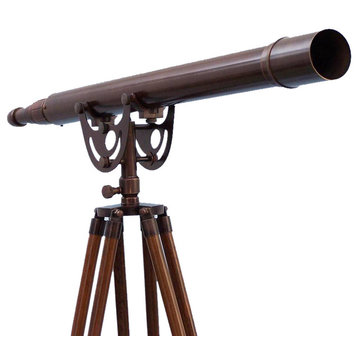
Floor Standing Bronzed Anchormaster Telescope 65'', Hand Telescope, Nauticalby Handcrafted Nautical Decor(1)
$350
The Floor Standing Bronzed Anchormaster Telescope 65" is a beautiful bronzed, refractor telescope mounted on a wooden tripod. This telescope is a fully functioning nautical masterpiece that adds class and sophistication to any room its in. This is a perfect nautical gift for the explorer in your life. The main scope is bronzed , which shines beautifully when placed in the sunlight. Focusing is accomplished by adjusting the eyepiece ring on the telescope tube, with up to 18x magnification. The wooden tripod stand features smooth, polished round legs, each with bronzed fittings and a screw release to let you adjust the height. ----Dimensions: 32.5" Long x 23" Wide x 65" High --- 18X Magnification -- Bronzed telescope body-- Glass optics for a clear view (not plastic lenses)-- Fully functional telescope focuses and magnifies-- Sturdy wooden tripod supports telescope when viewing-- --
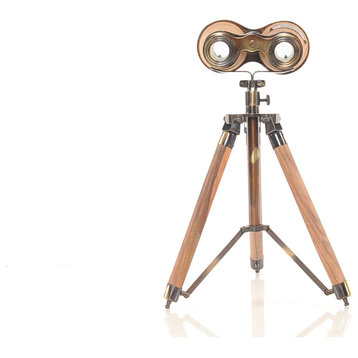
8" X 8" X 11" Wood Brass Binocular On Standby HomeRoots
$178
Free Shipping
Based on a 19th century design, these Victorian binoculars were the next big invention in eyewear after the single lens telescope. The tripod stand allowed for a hands-free experience, allowing users to do more while using the binoculars. A pair of these on your desk immediately adds a level of sophistication and elegance. ? Made out of wood and brass with a two-toned bright annealed finish
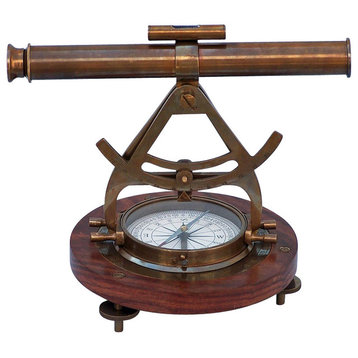
Alidade Compass, Antique Brass, 14''by Handcrafted Nautical DecorSponsored
$190
The Hampton Nautical Antique Brass Alidade Compass with telescope and bubble level is a beautiful nautical gem. Its beauty proves to be a perfect accent for spaces such as desktops, bookshelves, mantles, and more. This Antique Brass Alidade has a magnetic compass mounted beneath it for guaranteed accurate readings as well as a bubble level placed on the telescope for precise sightings. The alidade mounts on an antique brass support with a complimenting hardwood base. Three adjustable leg-screws are included for perfect balance. This antique brass nautical gem features a real working telescope, a fine-quality item for surveyors to align and measure vertical and horizontal angles functional antique brass telescope
- Adjustable compass for accurate measurements
- Bubble leveling and feet screws for precision and alignment
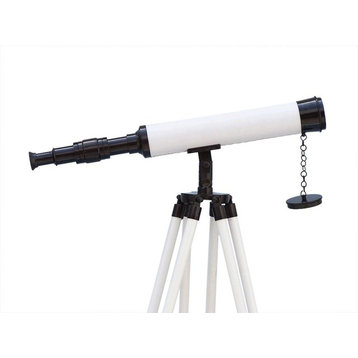
Floor Standing Bronze-White Leather Harbor Master Telescope 50''by Handcrafted Nautical Decor
$150
The Floor Standing Bronze with White Leather Harbor Master Telescope 50'', refractor telescope mounted on a wooden tripod. This telescope is a fully functioning nautical masterpiece that adds class and sophistication to any room it?s in. This is a perfect nautical gift for the explorer in your life. The main scope is bronze, which shines beautifully when placed in the sunlight. Focusing is accomplished by adjusting the eyepiece ring on the telescope tube, with up to 12x magnification. A removable bronze cap, connected by a chain, protects the objective lens.--The wooden stand features smooth, polished round legs, each with bronze fittings and a screw release to let you adjust the height. ----Dimensions: 18'' Long x 3'' Wide x 50'' High -------- 12X Magnification -- Bronze telescope body-- Glass optics for a clear view (not plastic lenses)-- Fully functional telescope focuses and magnifies-- Sturdy wooden tripod supports telescope when viewing-- Custom engraving/photo etching available: Logos, pictures or slogans can be easily put on any item. Typical minimum custom order is 200+ pieces. Minimum lead-time to produce and engrave is 4+ weeks.--
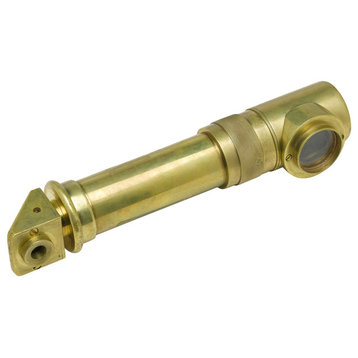
Handheld Brass Nautical Spy Scopeby Zeckos
$70
Free Shipping
- Measures 1.75 X 9 X 1.75 Inches
- Made Of Brass, Glass
- Adjustable Height
- Makes A Great Gift
- Brass nautical spy scope. Adjustable Height. Makes A Great Gift
- Made Of Brass, Glass. Measures 1.75 X 9 X 1.75 Inches.
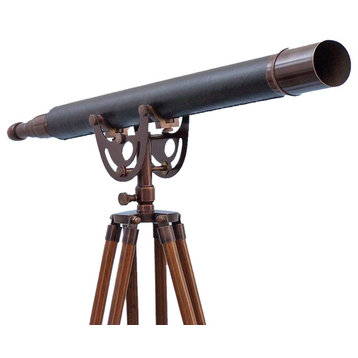
Floor Standing Bronzed With Leather Anchormaster Telescope 65''by Handcrafted Nautical Decor
$300
The Floor Standing Bronzed With Leather Anchormaster Telescope 65" is a beautiful bronzed with leather, refractor telescope mounted on a wooden tripod. This telescope is a fully functioning nautical masterpiece that adds class and sophistication to any room its in. This is a perfect nautical gift for the explorer in your life. The main scope is bronzed , which shines beautifully when placed in the sunlight. Focusing is accomplished by adjusting the eyepiece ring on the telescope tube, with up to 18x magnification. The wooden tripod stand features smooth, polished round legs, each with bronzed fittings and a screw release to let you adjust the height. ----Dimensions: 32.5" Long x 23" Wide x 65" High --- 18X Magnification -- Bronzed telescope body-- Glass optics for a clear view (not plastic lenses)-- Fully functional telescope focuses and magnifies-- Sturdy wooden tripod supports telescope when viewing-- --
Floor Standing Brushed Nickel With White Leather Galileo Telescope 65''by Handcrafted Nautical Decor
$250
The Hampton Nautical Floor Standing Oil-Rubbed Bronze with White Leather and Black Stand Galileo Telescope 65" is by far our standout choice amongst nautical enthusiasts worldwide. Constructed from 100% oil-rubbed bronze, this refractor telescope is mounted on a black wooden tripod. This telescope is a fully functioning nautical masterpiece that adds class and sophistication to any room its in. This is a perfect gift for the nautical explorer, an appropriate piece to spruce up an office for the busy executive, or perfectly position this exquisite telescope by your window sill to stargaze. The main scope is Oil-Rubbed Bronze wrapped in white leather, which shines beautifully when placed in the sunlight. Focusing is accomplished by adjusting the eyepiece ring on the telescope tube, with up to 15x magnification. A removable oil-rubbed bronze cap, connected by a chain, protects the objective lens.--The black wooden tripod stand features smooth, polished round legs, each with oil-rubbed bronze fittings and a screw release to let you adjust the height. An oil-rubbed bronze chain holds the three black wooden legs together so the telescope can maintain its position.--Dimensions: 30" Long x 24" Wide x 62" High--- 15X Magnification -- Oil-Rubbed Bronze telescope body-- Glass optics for a clear view (not plastic lenses)-- Fully functional telescope focuses and magnifies-- Sturdy black wooden tripod supports telescope when viewing-- --
2.6" X 40" X 58" Telescope With Standby HomeRoots
$564
Free Shipping
This is a fully functional harbor telescope. It is made of high quality brass. Each component is crafted with the finest craftsmanship. Harbour Master Telescope is available in antique brass finish. It comes with powerful optics with a viewing range 3 to 4 kms. Fitted on a beautiful rosewood adjustable tripod. This harbor master telescope is a great addition to any nautical collection or home decor. The item dimensions are: L: 40 inches, W: 2.6 inches, H: 58 inches w/stand.
60mm Mirror Refractor Telescope with Tripod Hey! Play!by Hey! Play!
$66
Free Shipping
Explore the universe with the 60mm Refractory Telescope by Hey! Play! This telescope is great for children and adults who are interested in astronomy and stargazing. The aluminum construction of the telescope and tripod make it lightweight enough to travel to your favorite spot to observe stars, planets and the moon as well as durable enough to handle the outdoors. The 60mm lens and 600mm focal range make finding celestial bodies easy, and the 50x and 100x magnification eyepieces bring them into focus. This refractory telescope will help lay the foundation for a lifetime of STEM (science, technology, engineering and mathematics) education for your child, and reinvigorate any adult's love of space exploration and scientific learning.
GREAT FOR BEGINNERS- This telescope is great for both children and adults who are interested in astronomy and stargazing. The 60mm lens and 600mm focal length make finding planets, stars and other celestial bodies a breeze!
TWO EYEPIECES- This telescope comes with both a 50X and a 100X magnification eyepiece for observing the night sky. These eyepieces will bring the moon, stars and closer planets into clear focus for stunning detail.
LIGHTWEIGHT AND DURABLE- Both the telescope and included tripod are made of aluminum. This makes them lightweight enough to travel to your favorite spot for stargazing. The aluminum also makes them durable enough to stand up to the outdoor elements.
FUN AND EDUCATIONAL- This telescope is designed to help find and identify planets and stars as well as observe the moon. It will lay the foundation for your child's STEM education and reinvigorate any adult's love of space exploration and science.
PRODUCT DETAILS- Materials: Aluminum, Glass and Plastic. Telescope Dimensions: 25" L x 2.75" H. Eyepiece Magnification: 50X and 100X. Lens Diameter: 60mm. Focal Length: 600mm. Includes Adjustable Tripod.
GREAT FOR BEGINNERS- This telescope is great for both children and adults who are interested in astronomy and stargazing. The 60mm lens and 600mm focal length make finding planets, stars and other celestial bodies a breeze!
TWO EYEPIECES- This telescope comes with both a 50X and a 100X magnification eyepiece for observing the night sky. These eyepieces will bring the moon, stars and closer planets into clear focus for stunning detail.
LIGHTWEIGHT AND DURABLE- Both the telescope and included tripod are made of aluminum. This makes them lightweight enough to travel to your favorite spot for stargazing. The aluminum also makes them durable enough to stand up to the outdoor elements.
FUN AND EDUCATIONAL- This telescope is designed to help find and identify planets and stars as well as observe the moon. It will lay the foundation for your child's STEM education and reinvigorate any adult's love of space exploration and science.
PRODUCT DETAILS- Materials: Aluminum, Glass and Plastic. Telescope Dimensions: 25" L x 2.75" H. Eyepiece Magnification: 50X and 100X. Lens Diameter: 60mm. Focal Length: 600mm. Includes Adjustable Tripod.
Oil-Rubbed Bronzed-White Leather With Black Stand Anchormaster Telescopeby Handcrafted Nautical DecorSponsored
$200
The Floor Standing Oil-Rubbed Bronzed/White Leather Anchormaster Telescope 65'', refractor telescope mounted on a wooden black tripod. This telescope is a fully functioning nautical masterpiece that adds class and sophistication to any room its in. This is a perfect nautical gift for the explorer in your life. The main scope is oil-rubbed bronze, which shines beautifully when placed in the sunlight. Focusing is accomplished by adjusting the eyepiece ring on the telescope tube, with up to 18x magnification.--The wooden black tripod stand features smooth, polished round legs, each with oil-rubbed bronze fittings and a screw release to let you adjust the height. ----Dimensions: 32.5'' Long x 23'' Wide x 65'' High -------- 18X Magnification -- Oil-Rubbed Bronze telescope body-- Glass optics for a clear view (not plastic lenses)-- Fully functional telescope focuses and magnifies-- Sturdy wooden black tripod supports telescope when viewing-- Custom engraving/photo etching available: Logos, pictures or slogans can be easily put on any item. Typical minimum custom order is 200+ pieces. Minimum lead-time to produce and engrave is 4+ weeks.--
Avalon Telescopeby Authentic Models(2)
$698
Free Shipping
Both decorative and functional, the Avalon Telescope makes a unique accent piece in an office or library. Featuring rich rosewood and solid brass hardware, this telescope has an elegant, classic appearance that complements traditional decor. A stand with adjustable legs makes for easy transportation and storage. Magnification is 20x.
Vintage Brass Metal Telescope 561751by Brimfield & May
$168
Free Shipping
Create an artistic display in your living space with this durable and eye catching telescope. A unique and distinctive old fashioned telescope decor that adds character and a nostalgic influence into your living space. Bring a hint of vintage style to your home space with this spyglass telescope decor on tripod for a sophisticated and elegant addition to your living room corners. This item ships in 1 carton. Please note that this item is for decorative use only. Metal telescope makes a great gift for any occasion. Suitable for indoor use only. Made in India. This is a single telescope. Vintage style.
Scout's Brass Spyglass 7'', Pocket Telescope, Childrens Telescope, Nauticalby Handcrafted Nautical Decor(9)
$25
The Hampton Nautical 7" Brass Spyglass is a great gift for the young nautical explorer in your life. This small brass spyglass is pocket sized, at 3.5'' when collapsed and 7'' when fully expanded. The handle of this spyglass is polished solid brass and comes with a solid brass cap to protect the lens.Simply adjust telescope length from lens to eyepiece to bring the image into clear focus. ----The 7'' spyglass is shipped in a beautiful felt-lined, brass-inlaid hardwood case. The box features brass side inlets on all sides and the Hampton Nautical solid brass anchor-with-rope logo on the top. The box is a smooth hardwood, gloss finished, measuring 4.5'' wide.--Dimensions:7'' L x 2'' W x 2'' H------ 3X Magnification-- Polished brassspyglass body-- Glass optics for a clear view (not plastic lenses)-- Fully functional spyglass focuses and magnifies-- Solid rosewood boxadorned with brass anchor emblem-- Custom engraving/photo etching available: Logos, pictures or slogans can be easily put on any item. Typical minimum custom order is 100+ pieces. Minimum lead-time to produce and engrave is 4+ weeks.----
Pocket Lighted Magnifierby Ultra-Optix Inc(6)
$21
Free Shipping
- "ULTRA OPTIX" POCKET LIGHTED MAGNIFIER
- 3X Power Lens Makes A Great Emergency Flashlight.Uses 2 "AAA" Batteries, Not Included.Blister Carded.
HomeRoots Vintage Look Brass Double Barrel Harbor Telescopeby HomeRoots Furniture
$202
Free Shipping
This is a functional replica of the harbor telescope. It is made of high quality brass finished with a bright shine. Each component is crafted with the finest craftsmanship. This double barrel telescope is fitted on a beautiful adjustable rosewood tripod. The item dimensions are: 2.25" x 17.5" x 26"
Captain's Brass / Leather Spyglass 15'', Hand Telescope, Telescope Hand Heldby Handcrafted Nautical Decor(14)
$50
The Captain's Brass - Leather Spyglass Telescope 15'' w/ Rosewood Box is a great gift for a nautical navigator in your family. The spyglass measures 15'' when its four brass tubes, which are clear coated to protect the brass from tarnishing, are fully extended. The diameter of the objective lens is 30 mm. The spyglass is 5'' when collapsed and features a stitched, leather wrapped handle. This spyglass also comes with a solid brass cap to protect the lens. Simply push in or pull out eyepiece to bring the image into clear focus.--The 15'' Spyglass is shipped in a beautiful felt-lined, brass-inlaid hardwood case. The box is smooth hardwood, with a gloss finish, featuring brass side inlets on all sides and the Hampton Nautical solid brass anchor-with-rope logo on the top.----Dimensions: 15'' L x 2'' W x 2'' H-- ---- 10X Magnification-- Glass optics for a clear view (not plastic lenses)-- Fully functional spyglass focuses and magnifies-- Polished brass spyglass with leather-wrapped body-- Solid rosewood box adorned with brass anchor emblem-- Custom engraving/photo etching available: Logos, pictures or slogans can be easily put on any item. Typical minimum custom order is 100+ pieces. Minimum lead-time to produce and engrave is 4+ weeks.----
Admiral's Spyglass Telescope With Black Rosewood Box, Chrome, 27"by Handcrafted Nautical DecorSponsored
$130
The Hampton Nautical Premium Quality 27" Chrome Spy Glass Telescope is a great gift for a nautical navigator in your family. The spy glass measures 27" when its four chrome tubes, which are clear coated to protect the chrome from tarnishing, are fully extended. The spy glass is 9" when collapsed and features a leather stitched handle. This spy glass also comes with a solid chrome cap to protect the lens. Simply adjust telescope length to bring image into focus.
The 27" spy glass is shipped in a beautiful felt-lined, brass-inlaid hardwood case. The box is smooth hardwood, gloss finished, featuring brass side inlets and the Hampton Nautical solid brass anchor-with-rope logo on the top. The box measures 9.5" wide and has a solid brass clasp in front
The 27" spy glass is shipped in a beautiful felt-lined, brass-inlaid hardwood case. The box is smooth hardwood, gloss finished, featuring brass side inlets and the Hampton Nautical solid brass anchor-with-rope logo on the top. The box measures 9.5" wide and has a solid brass clasp in front
- 12X Magnification
- Polished chrome spy glass body
- Glass optics for a clear view (not plastic lenses)
- Fully functional spy glass focuses and magnifies
- Solid rosewood box adorned with brass anchor emblem
Floor Standing Admiral's Brushed Nickel Binoculars 62'' Decorative Binocularsby Handcrafted Nautical Decor
$500
The Floor Standing Admiral's Brushed Nickel Binoculars 62'', complete with a rare and expensive shisham wood tripod stand, is the perfect gift for the explorer in your family. This is a functional nautical dcor item and looks great resting on a wood desk or between books on a wall cabinet. The picture of this amazing marvel does not do it justice.
The brushed nickel double scope enables its user to use both eyes to focus an object while keeping the binoculars steady with the stand. These binoculars are capable of reaching up to 12x magnification and can be focused using a knurled focusing ring in the center of the binoculars.
The tripod wood stand features polished and smooth rounded wood stands each with chrome fittings and a screw release to let you adjust the height. A chrome chain holds the three stands together so the binoculars hold their position.
The brushed nickel double scope enables its user to use both eyes to focus an object while keeping the binoculars steady with the stand. These binoculars are capable of reaching up to 12x magnification and can be focused using a knurled focusing ring in the center of the binoculars.
The tripod wood stand features polished and smooth rounded wood stands each with chrome fittings and a screw release to let you adjust the height. A chrome chain holds the three stands together so the binoculars hold their position.
- 12x magnification ultra large image size
- Brushed nickel binoculars weighs 10 pounds
- Beautiful woodtripod supportsand steadies binoculars
- Adjustable height of the tripod legs with ease
- Custom engraving available on large quantityorders (call us for information)
Metal, 13" Scope On Stand, Brownby Sagebrook Home
$134
Free Shipping
Display this stunning decorative scope in your library or study for a touch of old fashion style. Featuring a flawless finish and gold detail to portray an older fashion design. Perfect for a family with a classic and elegant aesthetic!
Vintage Silver Metal Telescope 562200by Brimfield & May
$166
Free Shipping
Create an artistic display in your living space with this durable and eye catching heirloom decor. A unique and distinctive decor that adds character and a nostalgic influence into your living space. Bring a hint of vintage style to your home space with this spyglass telescope decor on tripod for a sophisticated and elegant addition to your living room corners. This item ships in 1 carton. Please note that this item is for decorative use only. Metal telescope makes a great gift for any occasion. Suitable for indoor use only. Made in India. This is a single telescope. Vintage style.
Leather Telescope Boxby Sarreid Ltd
$450
Free Shipping
Leather Telescope Box, Keep journals, photos and special mementos protected within this handsome vintage style Antique Leather Telescope Jewelry Box. The rich tobacco leather exterior opens to reveal ring pads, slots for valuables and a mirror inside the lid. An inner removable tray provides another layer of organized storage. Antiqued brass corners and clasps enhance durability. The locking closure keeps contents securely stowed. Lined in archival paper, this jewelry box makes a refined addition to dressers, shelves and tabletops!
Floor Standing Anchormaster Telescope, Antique Copper, 65"by Handcrafted Nautical Decor(17)
$500
The Floor Standing Antique Copper Anchormaster Telescope 65'' is a beautiful, 100% antique finish copper, refractor telescope mounted on a wooden tripod. This telescope is a fully functioning nautical masterpiece that adds class and sophistication to any room it s in. This is a perfect nautical gift for the explorer in your life. The main scope is solid polished antique copper, which shines beautifully when placed in the sunlight. Focusing is accomplished by adjusting the eyepiece ring on the telescope tube, with up to 18x magnification. ----The wooden tripod stand features smooth, polished round legs, each with solid copper fittings and a screw release to let you adjust the height. A solid copper chain holds the three wooden legs together so the telescope can maintain its position.--Dimensions: 32.5'' Long x 3'' Wide x 65'' High -------- 18X Magnification -- Polished antique copper telescope body-- Glass optics for a clear view (not plastic lenses)-- Fully functional telescope focuses and magnifies-- Sturdy wooden tripod supports telescope when viewing-- Custom engraving/photo etching available: Logos, pictures or slogans can be easily put on any item. Typical minimum custom order is 100+ pieces. Minimum lead-time to produce and engrave is 4+ weeks.--
Premier® 84048 Internal Twist Telescoping Extension Pole, 4'-8', Stainless Steelby Premier Paint Roller Company, LLC
$114
Free Shipping
Sturdy, telescoping metal pole with standard threaded metal tips. Easy internal locking mechanism.
- Size: 4'- 8'
- Stainless steel
- Sturdy, telescoping metal pole with standard threaded metal tips
- Easy internal locking mechanism.
Antique Cooper With White Leather Anchormaster Telescope 65"by Handcrafted Nautical DecorSponsored
$200
The Floor Standing Antique Copper with White Leather Anchormaster Telescope 65''?is a beautiful, refractor telescope mounted on a wooden white tripod. This telescope is a fully functioning nautical masterpiece that adds class and sophistication to any room it?s in. This is a perfect nautical gift for the explorer in your life. The main scope is antique copper, which shines beautifully when placed in the sunlight. Focusing is accomplished by adjusting the eyepiece ring on the telescope tube, with up to 18x magnification. - The wooden white tripod stand features smooth, polished round legs, each with antique copper fittings and a screw release to let you adjust the height. - Dimensions: 32.5'' Long x 23'' Wide x 65'' High - 18X Magnification - Antique Copper telescope body - Glass optics for a clear view (not plastic lenses) - Fully functional telescope focuses and magnifies - Sturdy wooden white tripod supports telescope when viewing - Custom engraving/photo etching available: Logos, pictures or slogans can be easily put on any item. Typical minimum custom order is 200+ pieces. Minimum lead - time to produce and engrave is 4+ weeks. -
Nautical Telescope on Stand, Brass and Leatherby Handcrafted Nautical Decor
$70
The Hampton Nautical Solid Brass Telescope on Stand 17 - Leather is a true nautical gem that is both fully functional and beautifully decorative, adding a warm seafaring shine to any room it graces. The stand has an adjustable knob to change and hold a specific direction. Focusing is accomplished by adjusting the eyepiece ring on the telescope tube, with up to 10x magnification, and a solid brass cap is included to protect the lens when not in use.
The brass tripod stand features smooth, polished round legs, each with solid brass fittings and a screw.
Dimensions: 10" L x 8" W x 17" H
The brass tripod stand features smooth, polished round legs, each with solid brass fittings and a screw.
Dimensions: 10" L x 8" W x 17" H
- 10x magnification
- Fully functional solid brass leather-wrapped telescope
- High quality glass lens with adjustable focus
- Rests on adjustable brass tripod with solid brass fittings
Telescope on Stand, Chrome With Leather, 17"by Handcrafted Nautical Decor(2)
$70
The Chrome with Leather Telescope on Stand 17 is a true nautical gem that is both fully functional and beautifully decorative, adding a warm seafaring shine to any room it graces. The stand has an adjustable knob to change and hold a specific direction. Focusing is accomplished by adjusting the eyepiece ring on the telescope tube, with up to 10x magnification, and a solid chrome cap is included to protect the lens when not in use. The chrome tripod stand features smooth, polished round legs, each with solid chrome fittings and a screw.
Dimensions: 10" L x 8" W x 17" H
Dimensions: 10" L x 8" W x 17" H
- 10x magnification
- Fully functional solid chrome leather-wrapped telescope
- High quality glass lens with adjustable focus
- Rests on adjustable chrome tripod with solid chrome fittings
Floor Standing Bronzed Griffith Astro Telescope 65'', Ship Telescopeby Handcrafted Nautical Decor
$400
The Hampton Nautical Floor Standing Bronzed Griffith Astro Telescope 65" with view finder is the pinnacle of our wide telescope selection. This beautiful bronzed telescope is mounted on a wooden tripod. This telescope is a beautifully functioning nautical masterpiece, with a 42mm objective lens that produces up to 15x magnification.Focusing is accomplished by adjusting the eyepiece ring on the telescope tube and a removable bronzed cap, connected by a chain, protects the objective lens.--The wooden tripod stand features smooth, polished and round legs, each with bronzed fittings and a screw release to let you adjust the height. A bronzed chain holds the three wooden legs together to maintain the telescope's position.--Dimensions: 65" H x 25" W x 32" L---- 15X Magnification-- Bronzed telescope body-- Glass optics for a clear view (not plastic lenses)-- Fully functional telescope focuses and magnifies-- Sturdy wooden tripod supports telescope when standing-- -- Custom engraving/photo etching available: Logos, pictures, or slogans can be easily put on any item. Custom engraving available on large quantity orders (call us for information)--
Floor Standing Galileo Telescope, Antique Copper, 65"by Handcrafted Nautical Decor
$950
The Hampton Nautical Antique Copper Galileo Telescope 65" is by far our standout choice amongst nautical enthusiasts worldwide. Constructed from 100% copper with an antique finish, this refractor telescope is mounted on a wooden tripod. This telescope is a fully functioning nautical masterpiece that adds class and sophistication to any room it s in. This is a perfect gift for the nautical explorer, an appropriate piece to spruce up an office for the busy executive, or perfectly position this exquisite telescope by your window sill to stargaze. The main scope is solid copper with an antique finish which shines beautifully when placed in the sunlight. Focusing is accomplished by adjusting the eyepiece ring on the telescope tube, with up to 15x magnification. A removable copper cap, connected by a chain, protects the objective lens.
The wooden tripod stand features smooth, polished round legs, each with copper fittings and a screw release to let you adjust the height. A copper chain holds the three wooden legs together so the telescope can maintain its position.
Dimensions: 30" Long x 24" Wide x 62" High
The wooden tripod stand features smooth, polished round legs, each with copper fittings and a screw release to let you adjust the height. A copper chain holds the three wooden legs together so the telescope can maintain its position.
Dimensions: 30" Long x 24" Wide x 62" High
- 15X Magnification
- Antique Copper telescope body
- Glass optics for a clear view (not plastic lenses)
- Fully functional telescope focuses and magnifies
- Sturdy wooden tripod supports telescope when viewing
Monocular on Tripodby Authentic Models
$2,598
Free Shipping
Both decorative and functional, the Monocular on Tripod makes a unique accent piece in an office or library. Featuring hand-sewn leather and solid brass hardware, this monocular has an elegant, classic appearance that complements traditional decor. A stand with adjustable legs makes for easy transportation and storage.
5.5" X 3" X 5" Brass Binocular With Leather Caseby HomeRoots
$112
Free Shipping
Beautiful aluminum binoculars that provide a glimpse into the past. The binoculars come with a leather case to keep them safe from dust and scratches. ? Made out of brass with a shiny nickel finish ? Case made out of leather
Floor Standing Antique Cooper With Leather Harbor Master Telescope 60''by Handcrafted Nautical DecorSponsored
$350
The Floor Standing Antique Copper with Leather Harbor Master Telescope 60'', refractor telescope mounted on a wooden tripod. This telescope is a fully functioning nautical masterpiece that adds class and sophistication to any room it?s in. This is a perfect nautical gift for the explorer in your life. The main scope is antique copper, which shines beautifully when placed in the sunlight. Focusing is accomplished by adjusting the eyepiece ring on the telescope tube, with up to 15x magnification. A removable antique copper cap, connected by a chain, protects the objective lens.--The wooden tripod stand features smooth, polished round legs, each with antique copper fittings and a screw release to let you adjust the height. ----Dimensions: 32.5'' Long x 23'' Wide x 60'' High -------- 15X Magnification -- Antique Copper telescope body-- Glass optics for a clear view (not plastic lenses)-- Fully functional telescope focuses and magnifies-- Sturdy wooden tripod supports telescope when viewing-- Custom engraving/photo etching available: Logos, pictures or slogans can be easily put on any item. Typical minimum custom order is 200+ pieces. Minimum lead-time to produce and engrave is 4+ weeks.--
Telescope With Stand-40 Inchby Old Modern Handicrafts, Inc.(4)
$561
Free Shipping
This is a fully functional harbor telescope. It is made of high quality brass. Each component is crafted with the finest craftsmanship. Harbour Master Telescope is available in antique brass finish. It comes with powerful optics with a viewing range 3 to 4 kms. Fitted on a beautiful rosewood adjustable tripod. This harbor master telescope is a great addition to any nautical collection or home decor. The item dimensions are: L: 40 inches, W: 2.6 inches, H: 58 inches w/stand.
Floor Standing- Chrome Galileo Telescope 65''- Nautical Decor- Chrome Telescopeby Handcrafted Nautical Decor
$800
The Hampton Nautical Chrome Galileo Telescope 65'' is by far our standout choice amongst nautical enthusiasts worldwide. Constructed from 100% chrome, this refractor telescope is mounted on a wooden tripod. This telescope is a fully functioning nautical masterpiece that adds class and sophistication to any room it s in. This is a perfect gift for the nautical explorer, an appropriate piece to spruce up an office for the busy executive, or perfectly position this exquisite telescope by your window sill to stargaze. The main scope is solid chrome, which shines beautifully when placed in the sunlight. Focusing is accomplished by adjusting the eyepiece ring on the telescope tube, with up to 15x magnification. A removable chrome cap, connected by a chain, protects the objective lens.--The wooden tripod stand features smooth, polished round legs, each with chrome fittings and a screw release to let you adjust the height. A chrome chain holds the three wooden legs together so the telescope can maintain its position.--Dimensions: 30'' Long x 24'' Wide x 62'' High-------- 15X Magnification -- Chrome telescope body-- Glass optics for a clear view (not plastic lenses)-- Fully functional telescope focuses and magnifies-- Sturdy wooden tripod supports telescope when viewing-- Custom engraving/photo etching available: Logos, pictures or slogans can be easily put on any item. Typical minimum custom order is 100+ pieces. Minimum lead-time to produce and engrave is 4+ weeks.--
There’s an appealing allure that revolves around telescopes — both antique and functional. You might want to accentuate a travel- or nautical-themed room with the addition of a spyglass or beautiful brass telescope. If you’re a beginner stargazer, you might angle your lens toward the moon each night. For those wanting to get serious about looking out into the great beyond, here’s some basic information to consider when purchasing a new astronomical telescope:
While some professional astronomers recommend starting out with a pair of binoculars instead of a full-fledged telescope, there’s something almost romantic about peering out across the universe with a lens and tube design that’s been around since the 1600s. Keep in mind you’ll want to weigh quality over power when deciding between telescopes.
• Refracting telescope: The original design conceived by Galileo in the early 1600s, this style features a sealed tube and a convex objective lens. Just as Galileo peered out across the rings of Saturn, you can identify celestial bodies easily thanks to this style’s high image contrast. A quality refracting telescope is one of your more expensive options, but it will be well worth it when you spy the moons of Jupiter speckled across that celestial landscape. Beginners should aim for a 2.4- or 3-inch size.
• Reflecting telescope: If you’re looking for a more affordable option for the beginning astronomer, a reflector is the way to go. Unlike the refractor, it features a tube that’s open at one end and a concave mirror instead of an objective lens. If you’re just starting to delve into the wonders of space, look for a 4- or 6-inch model.
Catadiotropic telescopes: If you can’t decide between a refracting or reflecting style, you might want to consider a catadiotropic model. These tend to combine some of the best qualities of refracting and reflecting telescopes and are great for dark skies. A beginner should aim for a 3.5- to 5-inch model, which tends to be highly portable so you can take a peek at the night sky on that camping trip.
Dobsonian telescope: Another popular choice thanks to their ability to squeeze in a huge mirror and gather light from dimly light celestial objects. For the amateur sky gazer, a 10- to 18-inch model will do.
Most telescopes come with multiple eyepieces that change the amount of magnification, or power. A general rule to follow is that you want no more than 50 power per inch of aperture, though you might be surprised to discover that some of the best views can be found with lower powers. As an example, if you have a 6-inch reflector, you’ll want to go no higher than 300 power.
It’s very important to never look directly at the sun with your telescope, even if there’s some amazing solar activity occurring right this moment. Instead, project the image of the sun onto a white card or screen so you can safely view its beauty and power.
Some telescopes come with a dark glass filter that is supposedly for viewing the sun, however you should not use them. Why? Of course, looking at the sun with your bare eyes is painful, so why would you want to view it with a lens that’s magnifying that same brilliance? Also, the heat from the sun is intensified when your telescope is pointed toward it and this could cause that dark glass filter to crack. The worst-case scenario if this happens is partial or total blindness, which is not something you want to toy around with!
What kinds of backyard telescopes are there?
While some professional astronomers recommend starting out with a pair of binoculars instead of a full-fledged telescope, there’s something almost romantic about peering out across the universe with a lens and tube design that’s been around since the 1600s. Keep in mind you’ll want to weigh quality over power when deciding between telescopes.
• Refracting telescope: The original design conceived by Galileo in the early 1600s, this style features a sealed tube and a convex objective lens. Just as Galileo peered out across the rings of Saturn, you can identify celestial bodies easily thanks to this style’s high image contrast. A quality refracting telescope is one of your more expensive options, but it will be well worth it when you spy the moons of Jupiter speckled across that celestial landscape. Beginners should aim for a 2.4- or 3-inch size.
• Reflecting telescope: If you’re looking for a more affordable option for the beginning astronomer, a reflector is the way to go. Unlike the refractor, it features a tube that’s open at one end and a concave mirror instead of an objective lens. If you’re just starting to delve into the wonders of space, look for a 4- or 6-inch model.
Catadiotropic telescopes: If you can’t decide between a refracting or reflecting style, you might want to consider a catadiotropic model. These tend to combine some of the best qualities of refracting and reflecting telescopes and are great for dark skies. A beginner should aim for a 3.5- to 5-inch model, which tends to be highly portable so you can take a peek at the night sky on that camping trip.
Dobsonian telescope: Another popular choice thanks to their ability to squeeze in a huge mirror and gather light from dimly light celestial objects. For the amateur sky gazer, a 10- to 18-inch model will do.
What power levels I can choose for my telescope?
Most telescopes come with multiple eyepieces that change the amount of magnification, or power. A general rule to follow is that you want no more than 50 power per inch of aperture, though you might be surprised to discover that some of the best views can be found with lower powers. As an example, if you have a 6-inch reflector, you’ll want to go no higher than 300 power.
Are there any safety tips for telescopes I should know?
It’s very important to never look directly at the sun with your telescope, even if there’s some amazing solar activity occurring right this moment. Instead, project the image of the sun onto a white card or screen so you can safely view its beauty and power.
Some telescopes come with a dark glass filter that is supposedly for viewing the sun, however you should not use them. Why? Of course, looking at the sun with your bare eyes is painful, so why would you want to view it with a lens that’s magnifying that same brilliance? Also, the heat from the sun is intensified when your telescope is pointed toward it and this could cause that dark glass filter to crack. The worst-case scenario if this happens is partial or total blindness, which is not something you want to toy around with!






